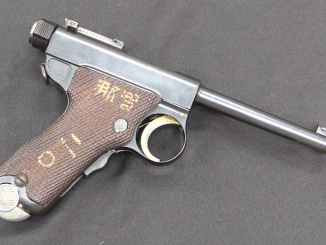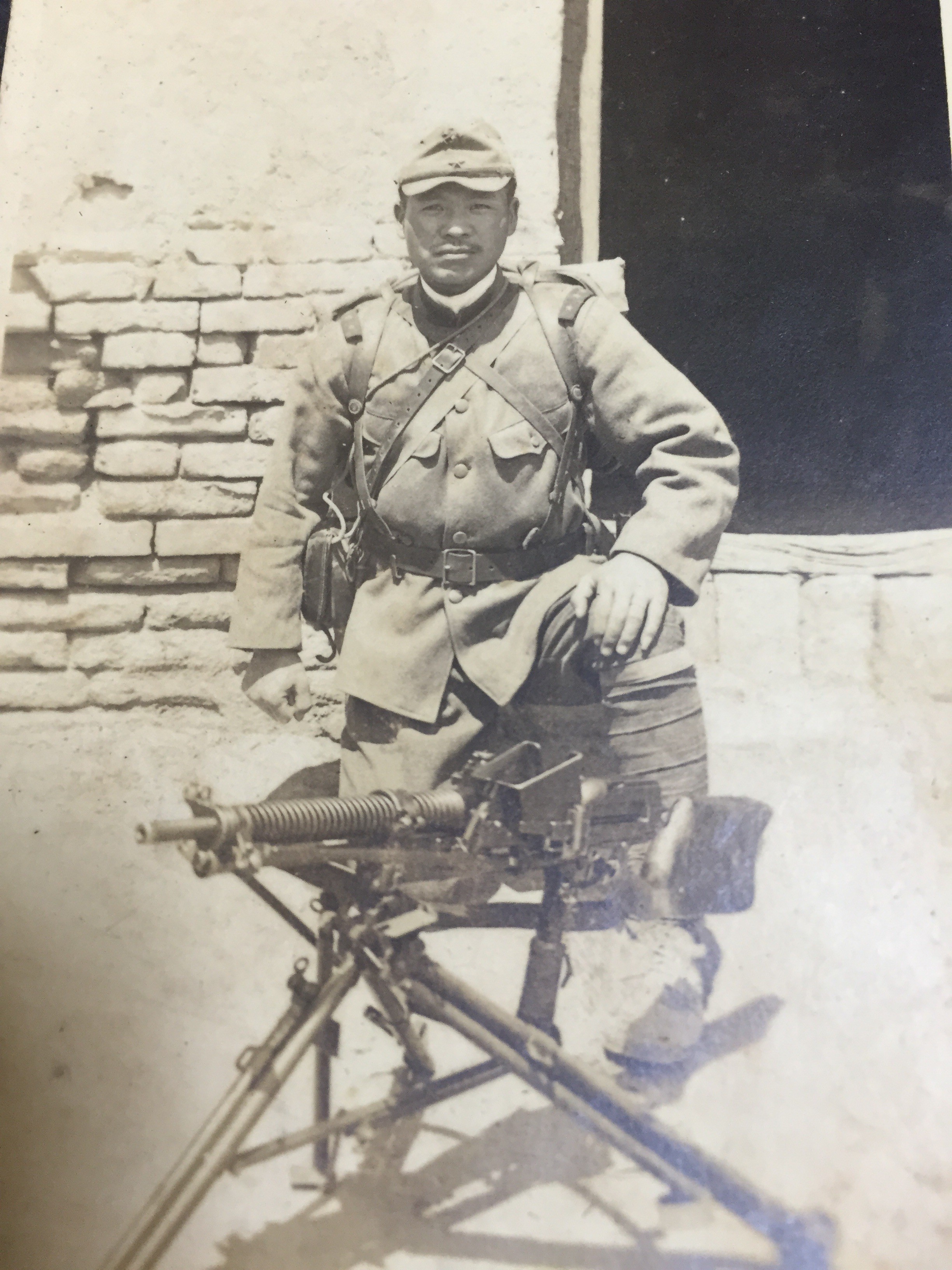The first Japanese exposure to firearms came from Portuguese traders in 1534, as the southern Japanese island of Tanegashima. They received a matchlock, and quickly recognized its utility and potential – within 10 years matchlocks were in significant production in Japan. The style of gun took hold nationally, and they became known collectively as “Tanegashima”. These matchlocks served as major military arms during the Japanese warring period between 1575 and 1638, and then remained standard arms until the reopening of Japan to the west in the mid 1800s.
The distinctive stock design of the Tanegashima is intended to be held and fired at the cheek, and not rested on the shoulder. The style of armor in use at the time did not easily allow a firearms to be shouldered, and so the cheek was used instead. Calibers varied from 8-9mm at the smallest up to guns well in excess of 1 inch in bore diameter. The example in this video is a very representative common type of about .50 caliber, but specialized versions also existed from short guns for mounted shooting and reloading to massive “wall gun” types.
With the closing of Japan to the outside world for several centuries, the matchlock Tanegashima became set as the standard firearm. Flintlock and wheel lock systems never saw any significant use, and small arms evolution only resumed with the Meiji Restoration in the mid 1800s, when the Emperor reformed the Japanese military along contemporary European lines. Today, the Tanegashima is a distinctive part of Japanese cultural history, although quite rare in the West and not widely collected.




By the way: for over a decade now, I have regularly found notes and comments that some Japanese matchlock guns’ pan cover opened automatically when the gun was fired.
I have no information about the details of the mechanism. I only have found pictures about the outside of the lock, here you are:
https://hu.pinterest.com/pin/552183604286641355/
May I have some information and pictures about the internal mechanism, please?
P.S.: for the record. I have found three matchlock mechanism with automatic pan cover.
1. Matchlock Caliver – Suhl ca. 1610
https://engerisser.de/Bewaffnung/weapons/Caliver.html
2. 18th century matchlock pistol from the island of Ceylon
http://historypistols.ru/…/fitilnyj-pistolet-18-veka/
3. Home made matchlock rifle – A modern one:
https://www.cascity.com/forumhall/index.php?topic=46263.0
I read this book awhile ago, it’s an interesting take on the stasis of Japanese firearm development after adopting the matchlock.
“Giving up the Gun” by Noel Perrin.
The fascinating thing, to me, has always been the Japanese development of drill for firearms. They were doing volley fire and using their firearms as disciplined blocks either as a parallel or before the Europeans… And, as near as my reading tells me, they did it in isolation from the Europeans like William of Orange, who is credited with bringing that concept back to life in Europe.
Arguably, the Japanese were doing more disciplined things with more men, to greater tactical effect than the Europeans of the time. It’s a large part of the reason why nobody ever managed to colonize Japan, one that hardly anyone notices.
The whole thing is poorly studied, badly documented, and… Utterly fascinating.
And, as per the usual manner of things, people are far more fascinated with the artifacts and the tools than the “software” side of things, like “Just how the hell did the Japanese come to develop the discipline and drill… Where did that come from, and why were they so good at it?”
In my admittedly unorganized study of Japanese history, the complication is that Japan has always been two societies, but its leaders have had motives to pretend otherwise. The stereotype of Japanese discipline is applied to the samurai class, but in reality when the feudal wars were real, samurai were all over the map in the discipline department as well as the loyalty department. The true discipline of Japan, I think, comes from the peasant culture of intense communal rice agriculture. If the musketeers of the final phase of the feudal wars came from that peasant class (which might not be the case) then it’s unsurprising that they readily took to mass formations and procedures, like the pikemen who were their predecessors.
The secret, then is the pikemen (or whatever long-poled weapons they used) who existed in armies all over the world, back to the Greek hoplites. Some lasted long enough to be converted to musketeers firing volleys. So you are then looking at a comparative study of how peasants are turned into pikemen, and pikemen then turned into gunmen.
The Japanese adapted their matchlock musket drill from Chinese military crossbow drill.
The Chinese were using the three-rank system (firing rank, retiring rank, loading rank) with their “pistol-grip” heavy crossbows as early as the 4th Century AD, long before “musket drill” was developed in the West.
During their wars with the Mongol rulers of China in Korea and etc., the Japanese shogunate armies were repeatedly exposed to Chinese crossbow mass volley fire. As Ian Hogg said, nothing gives you respect for a new weapon or tactic quite like being on the receiving end of same.
The Japanese briefly used heavy crossbows in the Chinese way, but then the Portuguese traders arrived with matchlocks, and the slightly older tactical formations were adapted to the new weapon technology.
Incidentally, while the “snapping” matchlock or tinder lock survived for three and a half centuries in Japan before being superseded almost overnight by metallic-cartridge breechloaders, its lifespan in Europe was only about thirty years. The fast downstrike of the snapping matchlock could extinguish the match cord just like blowing out a regular match, and the lockwork was more complex and expensive, being basically a forerunner of the miquelet lock, itself a native of the Iberian Peninsula. Europe quickly dropped the “snapping” matchlock in favor of the simpler and cheaper version used during the late 16th through the mid-17th Century until the advent of the flintlock.
Bore sizes of the Tanegeshima type military guns ran from 10 momme (1 momme weight=3.75 grams or 57.75 grains) firing a 37.5 gm or 578-grain bullet, through 20 momme, with a 75 gram/1,150-grain round ball, and on up to a 1 Kan size (1 Kan= 100 momme), firing a 3.75 kilogram or 8.25 pound ball. Some of these “big-bores” had barrels of about 60 cm/24 inches in length, and fired both lead or iron balls or “bombs”- hollow iron spheres filled with black powder and fired by a time fuze, another trick picked up from the Chinese. (Look up “thunderclap bomb” and “thundercrash bomb“, the latter being the iron-cased version.) In essence, they were grenade launchers. And yes, they were fired “from the cheek”.
By the way, the gun Ian showed us could just as easily have been a late military piece belonging to the “army” of a shogun during the Tokugawa or Edo period of peace from about 1603 to 1868. The family crest on the barrel was most likely the “property stamp” of whichever shogun’s army it belonged to, equivalent to the U S PROPERTY or “Broad Arrow” mark.
cheers
eon
It’d be an interesting avenue to explore, whether or not the requirements of successful rice farming translated into more easily drilled troops that were more likely to come up with such things. Looking at Japan, I can see where that would be a natural idea to develop, but… Other regions with abysmal military reputations that also do rice farming abound. Also, you’d have to explain why the Romans were so good at it, when their style of farming and the basic native cultures were so damn different.
I think there is something to be said for the essential Japanese nature being responsible for it all. After all, nobody in the West did what they did with their martial arts and so forth, turning them into what the Samurai class did with them.
You look at it from the perspective of an outsider, and you’re left going “WTF? Why’d they do that?” and trying to work out the whys and wherefores, which you’re almost certain to get at least partially wrong.
I do find it very, very interesting that the Japanese managed to turn out some highly lethal infantry formations armed with matchlocks, and that the Chinese during the same period were pretty much shambolic at the whole effort of trying to match the Western interlopers. One rather wonders what the Opium Wars would have looked like, if Japan had been the mainland power instead of the Chinese…
If you look at Japanese castles of that era, as in the Osprey book on the subject;
https://www.amazon.com/Japanese-Castles-1540-1640-Fortress-Turnbull/dp/1841764299
They don’t look like anybody else’s anywhere. The reason being that they were designed to maximize the effectiveness of matchlock musket fire downward on to enemy troops surrounding the prominence each castle was built on top of. Before gunpowder, they had been built similarly to maximize the effectiveness of archery.
The Japanese never developed gunpowder artillery to the degree that other nations did. They never had heavy pre-gunpowder artillery, either, such as trebuchets or onagers. In their view, war was all about killing enemy soldiers individually, preferably in large numbers. Meaning, a job for archery, and then musketry.
This also explains their restrictions on firearms down to the present day. Simply put, it ensured that what a shogun took by winning battles (villages, peasants, or tribute in specie- “ransom”), couldn’t be taken away from him by anybody but a more powerful shogun. Whom he likely swore fealty to. Anybody who thinks European feudalism was complicated shouldn’t try to figure out the Japanese version, which makes European hierarchies of fealties look simple by comparison.
Believe it or not, one of the most easily understandable versions outside of a book by Stephen Turnbull is the Akira Kurosawa movie Throne of Blood (Spider’s Web Castle) (1957). Granted, it’s essentially a haircut of Shakespeare’s “Scottish play”, but its description of the intermeshing loyalties that could trigger such a tangled mess is historically accurate.
As is the display of mass archery at the climax. The Welsh longbowmen had nothing on their Japanese counterparts, and no, the yumi was not just a weapon for samurai on horseback.
cheers
eon
An interesting historical matchup might be to imagine the Japanese at Crecy or Agincourt… Replacing the English with the Japanese might result in similar results to what we have in actual history, and replacing the French with the Japanese would be… Fascinating. I can’t picture any of the various Japanese leaders being quite as dense as the French were.
Either way, it’s probably a good thing that they were on the opposite side of the world from Europe. I can’t imagine what might have transpired, were they to swap places with the British Isles…
Alternate histories are such fun to think about.
I think the flower motives used are rather plum (ume) blossoms than cheries (sakura).
The formers are usually depicted with round petals and the latters with double-pointed ones.
Greetings from Japan